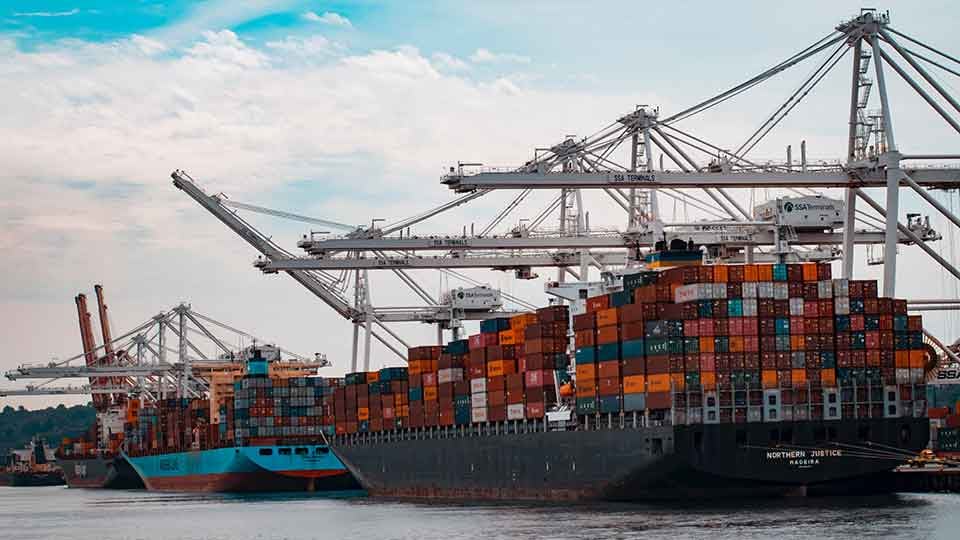Overseas shipping is a complex operation that requires multiple forms of transportation: typically at least one mode to get to the shipping port, one mode to get to the receiving port and one mode to get to the ultimate destination.
If your freight will be traveling overseas, chartering a vessel is one way to get it from port to port.
As a specialty shipping term, “vessel chartering” (also called “ship chartering”) is often misunderstood or completely unknown. While Anderson Trucking Service (ATS) is primarily known for trucking, we provide international shipping services including vessel chartering for overseas shipments. Our experience working with vessel chartering and other overseas shipping services means we can help you define these terms and what is required to move your freight in and out of the country.
If you are considering chartering a vessel or trying to decide the best way to move your freight to an overseas port, read on to learn:
- What is vessel chartering?
- What type of shipping vessel can I charter?
- What is the process to charter a vessel?
- What kind of freight is best for chartered vessels?
- How much does it cost to charter a vessel?
- What are the advantages to chartering a vessel?
- How can I charter a vessel for my overseas shipment?
- How to simplify the process of chartering a vessel with a freight forwarder
What Is Vessel Chartering?
Vessel chartering is the process of engaging a vessel (what laypeople would call a “ship” or “barge”) to transport your freight around the world.
There are two types of vessel-chartering services:
1. Full Charter
With a full charter, you are hiring the entire ship to transport just your freight. With a full charter, you specify the route and timing when your freight will arrive at its ultimate destination. You do not have to fill the entire vessel when you have a full charter, but transporting a larger amount of cargo will make a full charter more cost effective.
2. Part Charter
With a part charter, you engage only the space on the vessel you need to move your specific freight. A part charter is a less expensive option than a full charter; in exchange, your freight will share the vessel with freight from multiple shippers and you will not have control over the vessel’s specific route or schedule to your destination port.

Types of Cargo Ships for Chartering
Several vessel types are available for chartering.
- Geared vessels contain loading equipment such as ship-mounted cranes. Geared vessels are best suited for transporting extra large equipment or when using a port that does not have the required crane equipment.
- A bulk vessel or bulk carrier is customized to transport unpackaged dry cargo (such as commodity agricultural products, salt, sand and other types of dry bulk materials).
- Flat-deck barges are simply vessels with a flat surface where freight containers or other bulk or loose cargoes can be stacked or loaded for transport.
The type of freight you will be transporting, as well as the conditions at port, will dictate the type of vessel you require.
Chartering a Cargo Ship
Chartering a vessel is an enormous undertaking and requires extensive advance planning. If you are considering chartering a vessel to ship overseas, be prepared to consider the following 5 factors, which will impact the timing for your shipment:
Factor 1: Vessel Availability
Chartering a vessel requires sourcing a ship and crew that is available for your shipment. Because individual vessels may be occupied for weeks at a time, it can take 30-60 days before a vessel is available to you.
Factor 2: Free Time at Port
Ports, especially international ports, are bustling hubs of activity. Some will limit the time that they are accepting new freight, which you will need to coordinate with the availability of a vessel.
Factor 3: Storage Time at Port
Port space is at a premium. Most ports have a strict limit for on-site freight storage. You will need to move your freight within the allotted time in order to avoid high storage fees.
Factor 4: Freight Availability
You will need to coordinate getting your freight to the port, unloaded from the truck and loaded onto the vessel within the allotted time frame. If you encounter other supply chain delays, you may lose the availability of your vessel and could face substantial cancellation charges, otherwise known as “deadfreight.”
What Kind of Freight Can Ship on Chartered Vessels?
Typically, heavy-lift, non-containerized and large volumes of cargo are best suited for chartered vessels.
Heavy Lift Cargo
Heavy cargo that requires specialty cranes to load and unload are often shipped via chartered vessel. If the origin or receiving port does not have the equipment required to load and unload your freight, it may be best to charter a geared vessel.
Non-containerized (Breakbulk) Cargo
Oversize and overweight items are well suited for chartered vessels. A chartered vessel will have plenty of space for wind turbine components, generators, enclosures, power generating equipment, mining equipment and oil and gas refinery equipment.
For example, a chartered vessel was used for a project ATS was involved in to move components for eight massive wind turbines from the mainland U.S. to a port on the south shore of Oahu, Hawaii. Because of the size and number of turbines to be moved, a chartered vessel was a cost-effective solution.
Large volume shipments
Even if your freight fits neatly into containers, when managing a large enough order, it may make sense to charter an entire vessel. For smaller shipments, a partial charter or liner service is likely to be a better fit.
How Much Does It Cost to Charter a Vessel?
Like most transportation and logistics solutions, there is no one-size-fits-all answer when it comes to price. Plan to pay at least $150-500 per weight/measure (freight is measured by both cubic meter and metric ton; you will be charged based on the larger of the two measurements).
In addition to the size of the load, there are several factors that will drive the cost of chartering a vessel:
- Point of origin. Some ports may charge additional fees for your type of cargo or vessel. In addition, if you will be using a port that is a long distance from your manufacturing or warehousing facility, you will incur higher pre-carriage transportation costs for your freight.
- Destination. Similar to point of origin, some ports will be more costly for your timeline and handling needs.
- Distance and route. The greater the distance between your origin and destination, the higher the cost due to increased fuel and labor costs. Restricted points en route such as canals will also increase the route fees.
Of course, these factors include only water transport. You will also need to budget for the ground transportation of your freight before and after it arrives at port.
What Are the Advantages to Chartering a Vessel?
Chartering a vessel gives you the most visibility and control of the ocean routing. Your freight will be on a direct route, allowing you more flexibility in shipping time. This can also make it easier to promise a delivery date to your consignee.
When shipping a large amount of goods, as opposed to breakbulk items or equipment, a chartered vessel also simplifies the tracking process by giving you a single bill of lading and one vessel to track instead of multiple tracking requirements.
How Can I Charter a Vessel for My Overseas Shipment?
Vessel chartering requires significant coordination and can take months of preplanning. You are responsible for ocean transport, as well as both the loading and unloading at ports. The booking party must contract union labor at both the port of departure and arrival, as well as coordinate terminal handling, storage, wharfage and stevedoring.You will also need to arrange ground transportation to your port of origin and from your destination port.
Anytime you are shipping this magnitude of freight over this distance, you introduce multiple potential problems–including weather delays, labor problems, timing issues and freight damage. If you charter the vessel yourself, you will be responsible for solving these problems (and/or paying any additional fees that can be incurred during transit).
What Is a Freight Forwarder?
Fortunately, it’s possible to charter a vessel without coordinating this all yourself. Hiring a qualified and experienced project freight forwarder gives you the convenience of chartering a vessel without the hassle of coordinating all the moving pieces.
The freight forwarder is responsible for booking the vessel and coordinating on-the-ground transportation to and from each port. You will work with the forwarder to specify the type and size of the freight, the shipping dates and the destination. They will handle all other details.
Using a freight forwarder also simplifies the shipping process by providing a single point of contact and a single source of responsibility. You will not be stuck relaying messages to multiple vendors or determining who is responsible for delays or additional fees.
How to Charter a Vessel
Shipping overseas is a complex operation, with many options to consider – including the option to charter a vessel. Fortunately, you have options. You can use the information contained in this article to start the process of sourcing and chartering a vessel on your own. If you prefer to eliminate the hassles of chartering the vessel yourself, ATS has an experienced team of experts ready to help.
Contact us today for more information on out international freight forwarding (and vessel chartering services.





